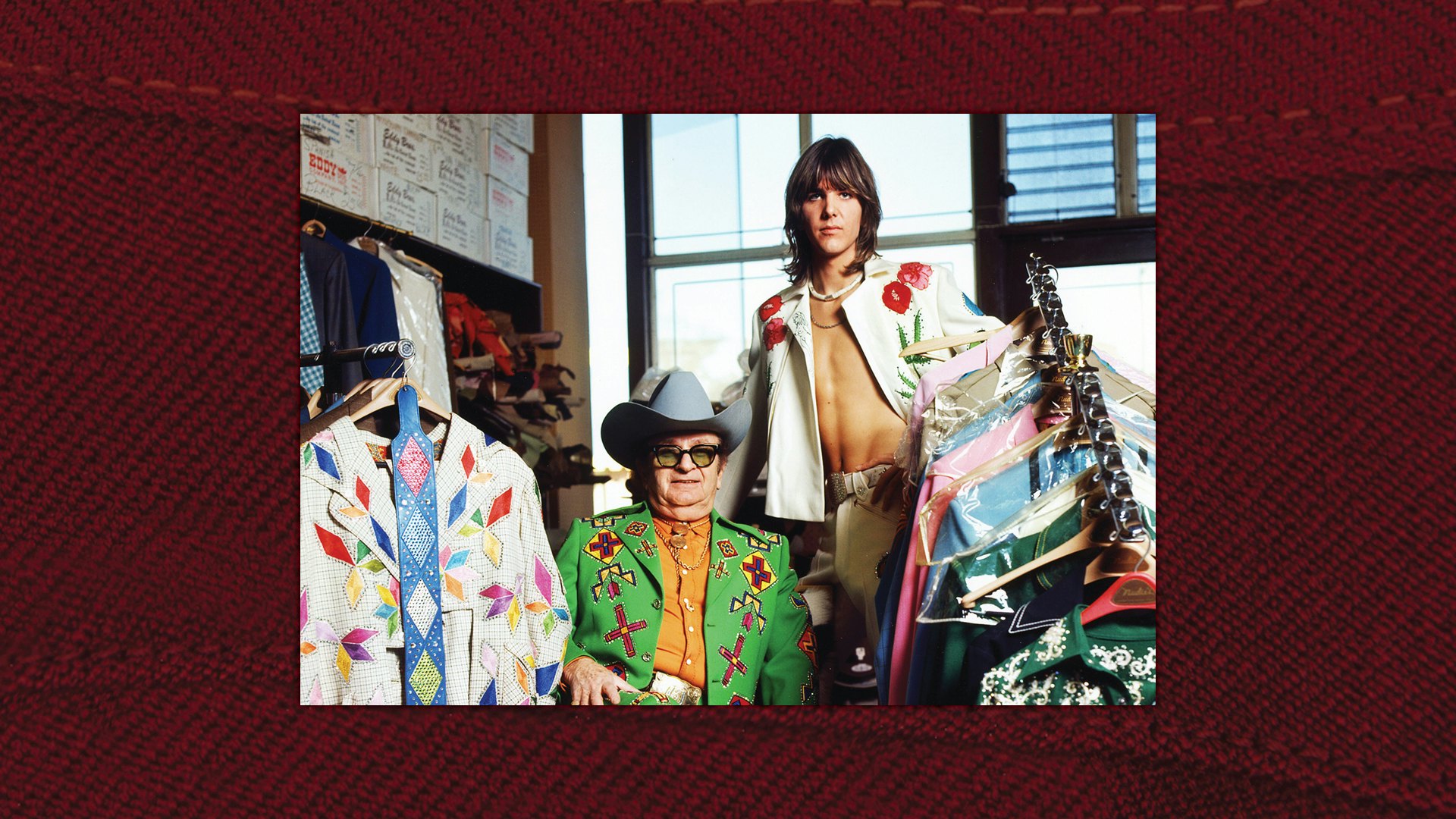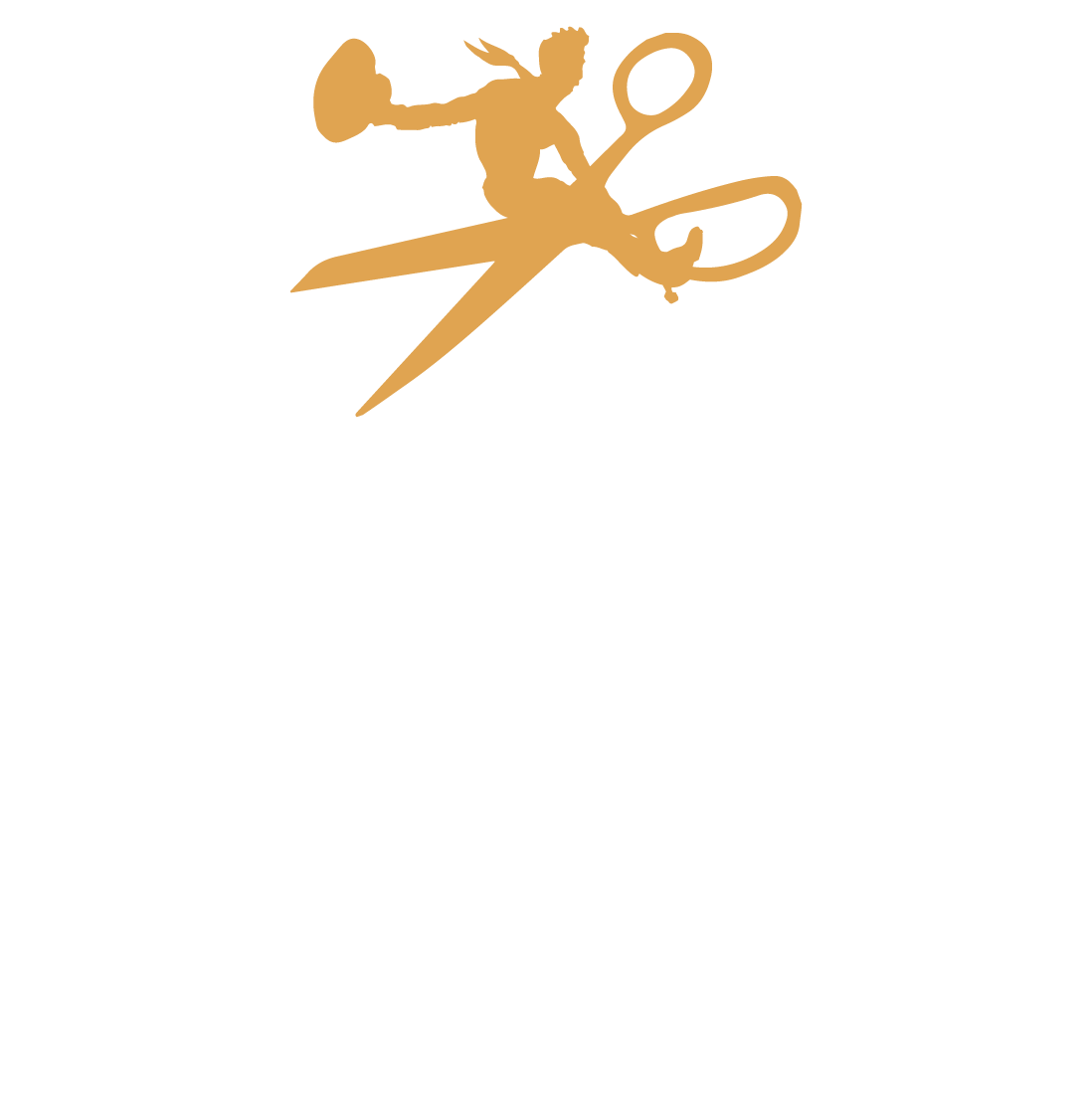

Nudie Cohn and the Flying Burrito Brothers’ Gram Parsons at Nudie’s Rodeo Tailors, 1969. Photo by Raeanne Rubenstein
Part Four
Nudie Cohn:
The Original Rhinestone Cowboy
The colorful individual behind the “Nudie suit”—a universal name for the outrageously embellished stage costumes that became status symbols in country music circles in the 1950s and beyond—embodied the American Dream. Born Nutya Kotlyrenko in Kiev, Russia, in 1902, he became a tailor’s apprentice at age eight. At eleven, his parents sent him to the United States to escape anti-Jewish pogroms in Czarist Russia. Like many immigrants, the Kotlyrenko family shortened their name, and according to the Cohn family, Nutya went by “Nudie” after a customs agent at Ellis Island misunderstood his name.
In 1934, Cohn and his wife, Bobbie, opened Nudie’s for the Ladies in Manhattan, where he designed rhinestone-embellished costumes for chorus girls and strippers. Within a few years of relocating to Los Angeles in the 1940s, Cohn began making stage wear for western swing musicians he and Bobbie befriended at local nightspots. In 1950, the couple opened Nudie’s Rodeo Tailors, the North Hollywood storefront and tailoring shop where Cohn would cultivate a celebrity clientele that included country and rock royalty—ranging from Hank Williams and Johnny Cash to Elvis Presley and Elton John. Cohn, who died in 1984, left a sparkling legacy, which is carried on through the bespoke Western wear created by protégés and acolytes such as Manuel Cuevas, Jaime Castaneda, and Union Western’s Jerry Lee Atwood.
Nudie Cohn, The Jimmy Dean Show, 1964


Detail of a Nudie suit designed for Hank Snow.



Lefty Frizzell, c. 1951
Put On Those Rhinestones!
Lefty Frizzell
Nudie Cohn’s signature design innovation was inspired by singing sensation Lefty Frizzell, who dominated the country charts in the early 1950s with #1 hits such as “If You’ve Got the Money (I’ve Got the Time).” The first time he met Frizzell, in 1951, Cohn thought the handsome crooner would look terrific wearing rhinestones and made him an outfit with a smattering of the reflective crystals. Frizzell was delighted with the audience response to his shimmering new stage costume. From then on, every time he ordered a suit, Lefty instructed Cohn to “put on a few more rhinestones, Nudie, put on those rhinestones!”

“Lefty” is spelled in red and green rhinestones on the pull straps of Frizzell’s boots from Nudie’s Rodeo Tailors.
One of the first items of stage wear designed by Nudie Cohn for Lefty Frizzell, in 1951, this shirt features long, contrasting suede fringe; piping; six-snap shotgun cuffs; and Frizzell’s initials on the yoke, outlined in rhinestones.



Lefty Frizzell helped popularize Nudie Cohn’s over-the-top designs with other country performers in the early 1950s. Frizzell’s trend-setting wardrobe included this lace-up-front shirt and pants ensemble with leather fringe, piping, rhinestone accents, and appliquéd wagon wheels and horses.




Hank Snow on his trick pony, Shawnee, outside his Rainbow Ranch barn in Madison, Tennessee.
Rainbow Ranch
Singer, songwriter, and guitarist Hank Snow, who passed away in 1999, bequeathed to the Country Music Hall of Fame and Museum a large collection of his stage clothing made by Nudie’s Rodeo Tailors.

Theme Weaver
Pictorial suits with themed embroidery, referencing an artist’s name or illustrating a hit song, were a Nudie Cohn style innovation. Some of Nudie’s embroidered motifs reflected his and his clients’ fascination with the stylized and often stereotyped images of the Old West and “cowboys and Indians” portrayed by Hollywood in movies and TV shows.

T. Texas Tyler
T. Texas Tyler, “Deck of Cards”
This double-breasted jacket was designed by Nudie Cohn for singer T. Texas Tyler, c. 1950. Embellished with contrasting piping, smile pockets with arrowhead stitching, and embroidered playing cards with rhinestone highlights, it represents Tyler’s 1948 signature hit, “Deck of Cards.” The velvet collar was a later addition.



Hank Thompson, “Humpty Dumpty Heart” and “The New Green Light,” 1964
Hank Thompson, “Humpty Dumpty Heart”
To commemorate Hank Thompson’s career-launching 1948 hit, “Humpty Dumpty Heart,” master embroiderer Viola Grae created the fantastical scene on his Nudie boots.

Hank Thompson, early 1950s



Hank Snow and Nudie Cohn, 1956. The pair, who became close friends, collaborated for many years on designs for Snow’s stage wear.
Hank Snow, “I’m Moving On”
Decorated with rhinestones and embroidered locomotives and lanterns, this themed Nudie suit illustrates Hank Snow’s 1950 chart-topping hit “I’m Moving On.” Snow, who insisted that “clothes are fifty percent of anybody’s act,” took an active role in designing his wardrobe. He detailed the look he wanted for this suit in a letter to Nudie Cohn, writing, “Hey there Ole Buddy…I would like a color something between an amber and a cream…and on the front of this coat, I would like a train on each side, preferably the old-time steam type…the smoke should be brown or black. On the two breast pockets should be a brakeman’s lantern.”




Webb Pierce wearing his jailhouse-themed Nudie suit, 1961. Photo by Walden S. Fabry
Webb Pierce, “In the Jailhouse Now”
Nudie’s Rodeo Tailors illustrated honky-tonk hero Webb Pierce’s 1955 chart-topping hit “In the Jailhouse Now” with this vividly embroidered, rhinestone-enhanced ensemble.




Porter Wagoner in one of his signature wagon wheel Nudie suits, c.1969.
Porter Wagoner, “Wagonmaster”
Playing off Porter Wagoner’s name, Nudie’s Rodeo Tailors designed a multitude of wagon-themed suits for the lanky singer and popular TV show host, including this bolero jacket and trousers festooned with rhinestones and embroidered wagon wheels, stagecoaches, and desert scenes. Courtesy of Debra Jean Loy




Ray Price, early 1960s
Ray Price, “Cherokee Cowboy”
In 1954, singer Ray Price parted with the Drifting Cowboys—the band he inherited from his friend Hank Williams after his death—and put together the first lineup of a group that would rank as one of the hottest road bands in country music for more than a decade. Recruiting members of a Texas band called the Western Cherokees, Price combined the two names to come up with the Cherokee Cowboys. In the hands of Nudie Cohn, the band’s name inspired dozens of stage suits for Price and his band that used depictions of Native Americans and their cultural objects and imitated Native American art.




Gram Parsons at Nudie’s Rodeo Tailors, 1969. Photo by Raeanne Rubenstein
Gram Parsons, “Sin City”
In 1968, trailblazing country-rock band the Flying Burrito Brothers went to Nudie’s Rodeo Tailors to be outfitted in the style of outrageous, rhinestone-studded suits they associated with real country music. The group’s front man, Gram Parsons, collaborated with Nudie’s head designer, Manuel Cuevas, to conjure this themed outfit that symbolizes the duality of sin and salvation. The sleeves, front, and lapels of the motorcycle jacket are embellished with chain-stitched marijuana leaves, pills, poppies and cartoonish pinup girls; the flames down the split-seam legs of the hip-huggers signify hellfire; and the embroidered cross gleaming on back represents redemption. Courtesy of Manuel Cuevas and Melanie Wells




Nudie’s Rodeo Tailors, 5015 Lankershim Boulevard, North Hollywood. Courtesy of Jamie Cuevas Nudie
Behind the Seams
Nudie’s Rodeo Tailors employed bootmakers, leather workers, alterations experts, embroiderers, tailors, and designers. In the shop’s early years, renowned embroiderer and designer Viola Grae—described as “a lovely little blond woman, full of energy, piss, and vinegar”—used a chain stitch embroidery machine to create the intricate decorations on Nudie’s designs. Her mantle was assumed by English-born master embroiderer Rose Clements, who handled all of Nudie’s embroidery after she arrived in Los Angeles in 1963. Other notable employees included Nudie’s chief designer, Manuel Cuevas, and tailor Jaime Castaneda, prior to each launching his own custom-tailoring businesses.
This life-size plastic horse stood outside Nudie’s Rodeo Tailors.
This life-size plastic horse stood outside Nudie’s Rodeo Tailors.

Tools
Tools used by the staff at Nudie’s included this Singer sewing machine, bootjack, and steam iron unit.




Nudie’s Rodeo Tailors outfitted this rodeo parade rider and her horse in fringe, appliqué, embroidery, and rhinestones in the 1950s.
Everything for the Horse and Rider
Nudie’s Rodeo Tailors carried “everything for the horse and rider,” including this Navajo-style tapestry and these hand-tooled boots.



Nudie Cohn with one of his creations. Courtesy of Jamie Cuevas Nudie
Showroom Piece
Sparkling with hundreds of rhinestones, this suit with multi-colored, diamond-pattern embroidery was a showroom piece at Nudie’s Rodeo Tailors. The ensemble includes a red western shirt; gold lamé neck scarf with rhinestones and appliquéd floral motifs; and gold lamé, rhinestone-studded belt and buckle.




Nudie’s Rodeo Tailors Catalog
Nudie’s “Western Style Roundup” catalogs advertised a wide range of the store’s Western apparel and goods.

Nudie Suits and Boots

Nudie Suits and Boots
The Country Music Hall of Fame & Museum houses a substantial collection of stage wear designed by Nudie’s Rodeo Tailors for country music artists, including some of the genre’s most celebrated.
See More Nudie Designs


















